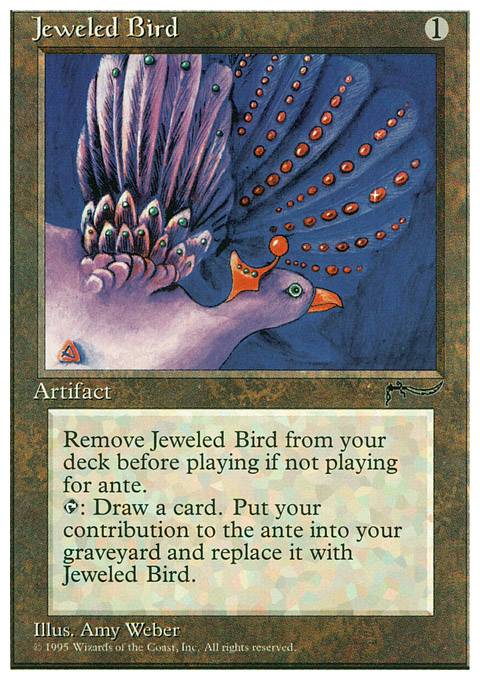
Combos Browse all Suggest
Legality
| Format | Legality |
| Archenemy | Legal |
| Casual | Legal |
| Commander: Rule 0 | Legal |
| Custom | Legal |
| Highlander | Legal |
| Leviathan | Legal |
| Limited | Legal |
| Oathbreaker | Legal |
| Planechase | Legal |
| Premodern | Legal |
| Quest Magic | Legal |
| Tiny Leaders | Legal |
| Vanguard | Legal |
Jeweled Bird
Artifact
Remove Jeweled Bird from your deck before playing if you're not playing for ante.
Tap: Put Jeweled Bird into the ante. If you do, put all other cards you own in the ante into your graveyard, then draw a card.
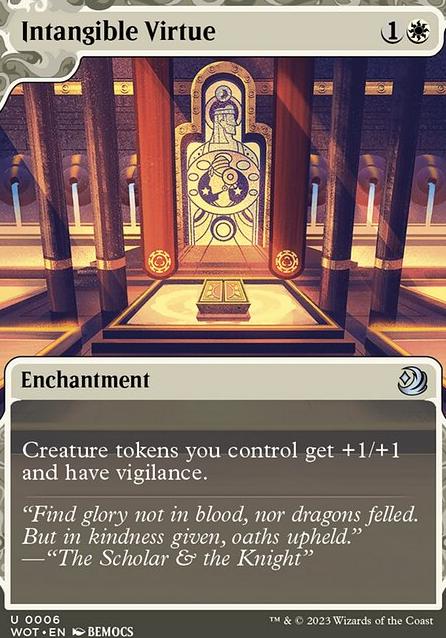
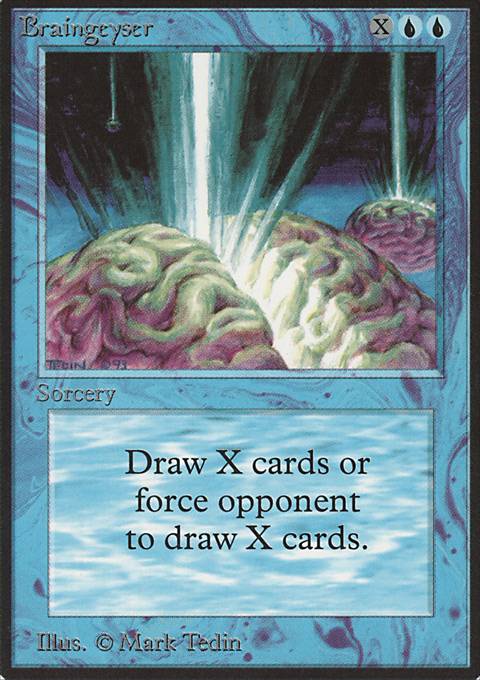
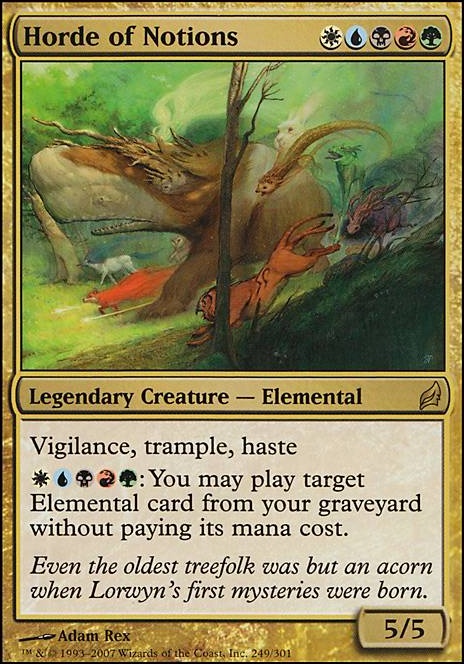
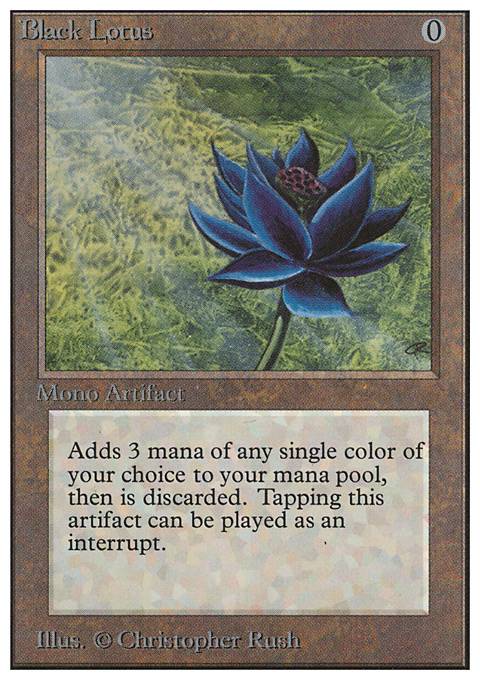
Caerwyn on Cube idea, good or bad? …
10 months ago
Only from analysis, but I feel fairly confident in that analysis. Consider:
-
The average ante card is likely to hit a land 42.5% of the time (17/40 - a fairly standard land base in Limited). Of those, you’re very likely to hit a basic land - which you could have gotten out of the basic box anyway.
-
Even in a colourless heavy meta, your odds of hitting a colourless are going to be pretty low. The odds you hit a colourless card which also improves your strategy or also debilitates your opponent’s deck are pretty low (and the odds of debilitating your opponents deck being worthwhile for you - meaning you hit the card in game one or two - are even lower).
The odds just are not on the side of Ante being fun, and that’s before we look at the cards themselves:
-
Amulet of Quoz either turns the game into a literal coin flip or is just exiling a single card from the top of an opponent’s library. Either it is a troll card if it resolves which can cause issues with folks twiddling their thumbs waiting for rounds to end or it is a mediocre mill card someone spent 6 mana for.
-
Bronze Tablet - maybe playable. Maybe. It is a ten mana theft piece that allows your opponents to take something back from you. That means for it to be playable, you must be in the position where you can play a 6-mana artifact, and activate it (either that turn or by surviving a turn), have something on your opponent’s side worth taking, have nothing on your side better than what you would take, and be in a position where your opponent won’t just take back what you stole. There’s a lot of things that must go right to make the card playable.
-
Contract from Below - Arguably the most powerful card ever printed in the entire game, this has no place in your cube. It’s just too good, especially in 40 card decks. Every time it is played, it is likely to be the game decider all by itself.
-
Darkpact - interacts badly with the math above. Odds are nothing will be worth claiming from ante, making this a three mana card just sitting about doing nothing in your hand.
-
Demonic Attorney - Really bad card with the above math. You’re spending 3 mana to very likely get something completely useless to you into ante.
-
Jeweled Bird - One mana for something that can only recover a card you likely can afford to lose. It would feel great if you got unlucky with what you ante, but otherwise it is almost always going to be a dead card.
-
Rebirth - Awful, awful card for limited. This stretches out games and can interfere with the timing of rounds.
-
Tempest Efreet - Again, the math is bad for this card, particularly since you’re going into an unknown zone and your opponent goes into the choice with perfect knowledge of their risk.
-
Timmerian Fiends - In an artifacts matters cube where there is heavy artifact recursion, this might be playable. Still, it requires a very specific set of circumstances for someone to draft into and make it worthwhile.
I should probably add the caveat that some players might find it fun, even if the math makes it very, very clear that the Ante cards are all traps (excepting Contract, which, again, is just too darn good).
Caerwyn on Land Destruction: A social conversation
5 years ago
I am a bit late to the party here, and have only skimmed the replies, so I'll probably be a bit repetitive. Still, this is a topic I've put a bit of thought into, so wanted to share my own points.
First, I don't have a problem with land destruction. In fact, in a very sadistic way, I enjoy playing against it. Land destruction, like any resource denial deck, is somewhat terrifying to play against--you're on a clock, and each turn, your enemy is slowly building up their resources, while you're increasingly stagnating. As the person against land destruction, I love how it forces me to think about my resources, carefully planning ahead, terrified those resources might suddenly vanish.
However, I understand the dislike others have for land destruction, and, in the interest of playing devils advocate to myself, am about to ramble a lot about why players see MLD as different from other control methods.
Speaking really generally, Magic has several different resources. In most games, there's the library, your life total, your graveyard, cards in your hand, cards on the stack, the command zone, nonland permanents on the battlefield, and lands (they're both on the battlefield, but fill very different roles, so I think it's fair to treat them as different resources). Some cards allow you to use cards in exile (ex. Squee, the Immortal) as a resource, and two (Darkpact and Jeweled Bird) allow you to use cards in the now-defunct Ante zone as a resource.
There exists denial of most all of these resources.
The library is the weakest resource--it generally doesn't do anything for you until those cards are actualized and put into your hand. Mill, and library exiling effects, can be considered "library denial." These strategies tend to be weak--you're not actively interacting with a resource that matters. It's a bit silly to get upset about being the target of library denial, as your opponent is only going after a weak resource--yes, they might sometimes hit your win condition, but they are also likely to miss it entirely--after all, they have very little control over what they're actually denying.
Life denial is pretty clear--combat damage and burn spells. If your deck is not prepared for life denial, you've made a serious miscalculation. This is, after all, probably the most common type of resource denial.
Graveyard denial exists in many forms, such as Tormod's Crypt. Not everyone uses the graveyard as a resource, and, those who do, need to be sure to protect against graveyard denial. If they don't, that's on them--not the person countering their strategy.
Cards in hand - Duress. This is another one which, like MLD, many players find problematic--after all, you are denying them a resource they know about, but have not yet been able to use. This is mitigated some because you always have your draw step, so can conceivably still win or get ahead before the card is discarded.
Spells on the stack - counterspells. Again, this is such a fundamental part of Magic, it's expected, and you need to be prepared for it. That it is expected weakens the sting of this form of denial.
Nonland permanents - removal of all sorts. Same as life loss and counterspells--this is just a fact of Magic.
Now, rambling aside, on to Land Destruction.
Land destruction is resource denial that is not common, so many decks are not prepared for it. Unlike life/nonland permanent/counterspell-based denial, you don't see MLD as often, so many players have not mentally sealed themselves for this form of denial.
Second, with other forms of denial, you are likely to draw into a card that will help you--lands make up less than 50% of the deck, so you are less likely to draw one and "catch up" after some of your lands are axed.
Further, unlike counterspells or discard, which are only useful at certain times (a spell worth countering on the stack/cards in hand), land destruction can, and should, always be played, meaning a land destruction card is never a dead draw and there's no skill to using it as you can't fire one off at an inopportune time (i.e. countering the wrong spell, leaving a player open to cast a bomb).
Finally, when your spell is countered, your one turn behind, but can catch up next turn. With MLD, you are perpetually one, then two, then three turns behind, lacking the mana to even make a measly turn 2 play on turn 6.
Anyway, that's a bit ramble-y, but here is the TL:DR:
The combination of its rarity makes MLD "sting" a lot more to players. The fact it is relevant and never a dead draw or misfire makes it feel oppressive, and like the MLD-user doesn't need any real skill. Players don't like feeling as if they are perpetually playing catch-up.
Boza on Pattern Recognition #55 - Artifact …
6 years ago
OK, we are getting somewhere!
You say these problems are not artifact set related. I looked up all cards ever banned in standard. There are 43 of them. 21 are artifacts or work only in conjunction with them (for example, Disciple of the Vault, Tolarian Academy and Stoneforge Mystic are included in those 21). That is 50% of the cards banned in standard ever.
Now of those 21, Jeweled Bird was banned because Ante, while Black Vise was a card from alpha, but it was only restricted. The other 19 are all from artifact sets. Jitte was never even banned in standard!
Source:Banned cards in Standard
So, backed up by data, which you always fail to provide, every single artifact card that has ever been banned in standard has been from an artifact-centric set. That is not a "single card problem" this is obviously a design problem.
Rhadamanthus on When taking control of other …
6 years ago
Yes, you can gain control of those creatures with Homeward Path.
A player "owns" all cards that started the game in their deck, command zone, and sideboard, and all tokens that were first created under their control. Effects that put a card from the graveyard/library/etc. onto the battlefield under a different player's control don't change the ownership of a card. The only way to change ownership of a card during a game is by using a small handful of weird old cards that are only allowed if you started the game with the "Ante" rules option (Tempest Efreet, Jeweled Bird, etc.), which hasn't been a part of the official Magic rules for a very long time.
StopShot on New Format Idea: [Bullets]
7 years ago
The Bullets format is an eternal format in that decks can contain lands and cards with converted mana cost 1 only. All other cards are not legal in the format, such as zero-cost, two-cost, three-cost cards, etc. Any card with CMC 1 is legal, and any land printed in a Modern set is legal. (**Exceptions are on the banlist.)
The format itself is meant to be aggressive and rather unpredictable. The minimum deck size is 60. The maximum number of cards with the same name you can carry in your deck and sideboard is 4 with the exception to basic lands. Sideboards can only contain 15 cards.
The Bullets Format does have its own unofficial ban list.
The ban-list works like most other formats. Cards that would be legal in the format, but are placed on this list can not be played. This list consists of: Ancestral Recall, Candelabra of Tawnos, Contract from Below, Dark Depths, Demonic Consultation, Enlightened Tutor, Entomb, Gamble, Green Sun's Zenith, High Tide, Imperial Seal, Jeweled Bird, Mental Misstep, Mind Twist, Mystical Tutor, Personal Tutor, Skullclamp, Vampiric Tutor, and Worldly Tutor.
Potential Questions and Answers are listed below.
Why Modern set lands only? Lands are essential in any deck, and for such a fringe format the advantage a player with OG duel lands over someone with tap lands is too much especially when the format is strictly one-drops where speed is paramount. With the Ravnica shock lands there is more balance, especially with price tags.
Why isn't Sol Ring banned? In a format full of one-drops Sol Ring isn't around to ramp you into three and four drops on turn 2. When all your spells usually cost one type of color mana alone the advantages of having Sol Ring in your deck aren't as big as in other formats where its banned.
Please let me know if you have any questions, criticisms, or thoughts, thank you.
ErebusX on Gatewatch format
7 years ago
1.) In this casual, multiplayer format, you start with a life total of 30 (rather than the usual 20) and choose a Planeswalker (or legendary creature that transforms into a planeswalker) to serve as your General. You then choose cards to match your Generals color identity to build your deck. A card's color identity is any mana symbol appearing on that card.
2.) The Gatewatch deck contains 65 cards: 1 General and 64 others. Your deck may contain only one of any individual card, with the exception of basic lands.
3.) The General enters play in the general zone. You may cast your General from the general zone for its normal costs, plus an additional one mana for each previous time it's been cast from the general zone this game. If your General is ever headed to the graveyard or exiled, you may return it to its general zone instead.
4.) All cards, including your General, must have a Converted Mana Cost (CMC) of 6 or less. In the case of cards with X in their mana cost, X = 0 for the purpose of calculating CMC for construction purposes.
5.) In addition to the normal Magic win conditions, you can win in this format by raising your General's Loyalty to 30 or higher. If recast from the general zone, your General's loyalty always resets to its base value.
Banned List:
Advantageous Proclamation, Amulet of Quoz, Ancestral Recall, Backup Plan, Balance, Black Lotus, Brago's Favor, Bronze Tablet, Channel, Chaos Orb, Contract from Below, Darkpact, Demonic Attorney, Double Stroke, Doubling Season, Erayo, Soratami Ascendant, Falling Star, Fastbond, Gideon, Champion of Justice, Gifts Ungiven, Immediate Action, Imprisoned in the Moon. Iterative Analysis, Jace, the Mind Sculptor, Jeweled Bird, Library of Alexandria, Limited Resources, Mox Emerald, Mox Jet, Mox Pearl, Mox Ruby, Mox Sapphire, Muzzio's Preparations, Painter's Servant, Panoptic Mirror, Pithing Needle, Power Play, Primeval Titan, Prophet of Kruphix, Rebirth, Recurring Nightmare, Rofellos, Llanowar Emissary, Secret Summoning, Secrets of Paradise, Sentinel Dispatch, Serra Ascendant, Shahrazad, Song of the Dryads, Tempest Efreet, Thief of Blood, Time Vault, Time Walk, Timmerian Fiends, Tinker, Tolarian Academy, Trade Secrets, Unexpected Potential, Upheaval, Vampire Hexmage, Worldknit, and Yawgmoth's Bargain
Rhadamanthus on Commander Legality Question
8 years ago
Note that any cards banned in Vintage are also banned in Commander, though they don't specifically appear on the Commander ban list. This includes "ante"-related cards (Jeweled Bird, Timmerian Fiends, etc.), physical dexterity cards (Chaos Orb and Falling Star), Conspiracies (Backup Plan, Muzzio's Preparations, etc.), and Shahrazad.






